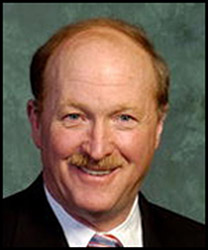Brigham & Women's Hospital

Thomas S. Thornhill, M.D.
John B. and Buckminster Brown Professor of Orthopaedic Surgery
Harvard medical school
2012-13 Chief's Report | ![]() PDF
PDF
Optical Coherence Tomography (Dr. Mark Brezinski)
Our program has advanced significantly, particularly since the addition of Valerie Jordan to the department. Advances can be divided into clinical/bench work, technology advancement, and education. These areas have progressed both through conventional channels as well as exploiting the power of social networking and communication technology.
Clinical/Bench Work
This area can be divided into our human arthroscopic studies, rotator cuff work (in animals and humans), animal models of RA, and quantum biology.
- 1. The in vivo arthroscopic study is the highest impact clinical work. OCT imaging was obtained of knee cartilage arthroscopically, as well as MRIs and conventional arthroscopies. The major point of interest in the study was areas abnormal by OCT but normal by the other modalities, which were then reimaged by MRI after three years. The year 0 data is published, and the last year 3 MRIs will be done by the end of this month. Preliminary data suggested areas abnormal by OCT (but normal by the other modalities) progressed to OA but it awaits final analysis. A limitation of this trial was that neither Scott nor I are clinical scientists, and Dr. Katz was over-committed, so it took 7 rather than 4 years. To pursue another clinical trial, the logical extension, we would need a clinical scientist (of Dr. Katz’s caliber) or hire a private company to run it.
- 2. We have done both human and animal rotator cuff imaging (of the repair). It has become clear that the repair contains only contains scar tissue. The direction of this research is tissue engineering, with our focus on OCT guidance of tissue engineering models. While these animal models were funded by the NIH in the past and are part of their mission statement, the reorganization has left these types of studies without a review committee. Therefore, we are actively looking for a tissue-engineering collaborator as the next logical step for this work on combining an OCT-imaging animal model with a specific therapy.
- 3. The mice RA work is done in collaboration with Dr. Brenner, and I can expand on it if needed.
- 4. Quantum biology is an active area for us; quantum processes that affect physiology. Prior examples from other groups are photosynthesis and magnetoreception. Our interest is in non-local communication between inflammatory cells, which has many applications in musculoskeletal diseases. It also is potentially relevant to tissue engineering, but this is not an area we have actively pursued. We have three publications on the topic and the fourth, which is the most critical, is submitted.
Technology
We have four provisional patents in the last three years, with three being related to improved performance. More relevant to the magazine would be our work on OCT adjuvant techniques (approaches beyond structural imaging). These include second order correlations (SOC) OCT for lipid or GAG concentration, polarization sensitive OCT for collagen organization and concentration, and OCT elastography for non-contact tissue stress measurements. The elastogarphy approach we have yet to file for patent protection. The SOC OCT is of particular importance, because besides being a new source of funding, it is a paradigm shift using quantum principles with conventional OCT.
Education
You probably know we have a very high success rate of getting team members into careers they desire. Both Chris’s are leaving the lab this summer, one to medical school and one to an orthopedics residency. We use what 8 years ago was considered an unorthodox training method, but is now becoming more orthodox, as our group will be featured in BWH magazine on this education issue. I can expand upon it if needed, but the article should be out shortly. Basically, rather than having lab meetings with their inherent inefficiencies, team members are given devices (ex; iPods) with lectures they can listen to when they are most receptive. Then they respond to or ask questions on the work. The focus is on what the world is currently demanding: brevity, simplicity, and self-learning.
Social Networking
We have been using social networking for years and continue to advance in this area to promote our work. We have numerous websites up (and are expanding), including OCTorthopedics.com, which is under construction. More importantly, we are well positioned with search engine optimization (SEO) and web analytics to continue expanding the exposure of our work. An additional example is that each paper published is announced on websites such as Linkedin, OCTNews, etc., which gives us much more visibility than traditional methods only.
Clinical
Clinically, Mark continues his interests in preventing patient joint injury and maintaining functionality with aging, focused on the knees, back, neck, and shoulders.
- BWH Chief's Report
- Clinical Services
- Arthroplasty
- Spine
- Sports & Shoulder
- Hand & Upper Extremity
- Foot & Ankle
- Podiatry
- Research Program
- Skeletal Biology
- OrACORe
- Nanotechnology
- OCT
